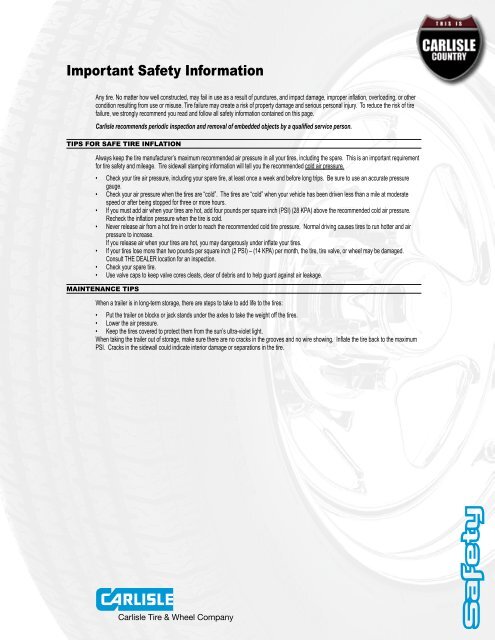2007 Trailer Tires & Wheels Catalogue(PDF) - Carlisle Tires
2007 Trailer Tires & Wheels Catalogue(PDF) - Carlisle Tires
2007 Trailer Tires & Wheels Catalogue(PDF) - Carlisle Tires
You also want an ePaper? Increase the reach of your titles
YUMPU automatically turns print PDFs into web optimized ePapers that Google loves.
Important Safety Information<br />
Any tire. No matter how well constructed, may fail in use as a result of punctures, and impact damage, improper inflation, overloading, or other<br />
condition resulting from use or misuse. Tire failure may create a risk of property damage and serious personal injury. To reduce the risk of tire<br />
failure, we strongly recommend you read and follow all safety information contained on this page.<br />
<strong>Carlisle</strong> recommends periodic inspection and removal of embedded objects by a qualified service person.<br />
TIPS FOR SAFE TIRE INFLATION<br />
Always keep the tire manufacturer’s maximum recommended air pressure in all your tires, including the spare. This is an important requirement<br />
for tire safety and mileage. Tire sidewall stamping information will tell you the recommended cold air pressure.<br />
• Check your tire air pressure, including your spare tire, at least once a week and before long trips. Be sure to use an accurate pressure<br />
gauge.<br />
• Check your air pressure when the tires are “cold”. The tires are “cold” when your vehicle has been driven less than a mile at moderate<br />
speed or after being stopped for three or more hours.<br />
• If you must add air when your tires are hot, add four pounds per square inch (PSI) (28 KPA) above the recommended cold air pressure.<br />
Recheck the inflation pressure when the tire is cold.<br />
• Never release air from a hot tire in order to reach the recommended cold tire pressure. Normal driving causes tires to run hotter and air<br />
pressure to increase.<br />
If you release air when your tires are hot, you may dangerously under inflate your tires.<br />
• If your tires lose more than two pounds per square inch (2 PSI) – (14 KPA) per month, the tire, tire valve, or wheel may be damaged.<br />
Consult THE DEALER location for an inspection.<br />
• Check your spare tire.<br />
• Use valve caps to keep valve cores cleats, clear of debris and to help guard against air leakage.<br />
MAINTENANCE TIPS<br />
When a trailer is in long-term storage, there are steps to take to add life to the tires:<br />
• Put the trailer on blocks or jack stands under the axles to take the weight off the tires.<br />
• Lower the air pressure.<br />
• Keep the tires covered to protect them from the sun’s ultra-violet light.<br />
When taking the trailer out of storage, make sure there are no cracks in the grooves and no wire showing. Inflate the tire back to the maximum<br />
PSI. Cracks in the sidewall could indicate interior damage or separations in the tire.<br />
<strong>Carlisle</strong> Tire & Wheel Company<br />
Safety



